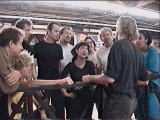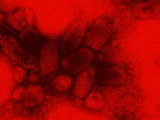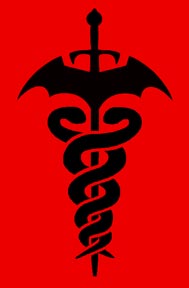WE ARE THE HUNTED... Like sharks in a feeding frenzy, vampires are drawn by the scent of those who have been bitten (unless masked by garlic pills), and will continue to drain us until we turn and become one of them, unable to exist without a constant supply of fresh human blood. Our only defense is to stick together. Several groups have been formed such as the VA (Vampires Anonymous) which meets on a regular basis to help members cope with various issues including blood addiction. Be warned: it is virtually impossible to distinguish vampires from the rest of us. The tell-tale fangs and glowing red eyes are present only when they are feeding, enraged, or captured in flash photography. They have spread throughout our society, from law enforcement and political figures, to executive producers responsible for the nonstop flood of vampire-related entertainment in Hollywood. And, like cockroaches, they have developed an immunity to practically everything over the years: crosses, sunlight, and holy water have no effect, and a stake in the heart just pisses them off. The only way they can be killed is to remove their head from their body. Thus, many of us have become skilled swordsmen (and women) and call ourselves Slayers. But even though some of us have acquired a hint of their invulnerability, strength, and speed, we have not acquired their powers (many of which are still unknown to us), we are not immortal, and we can be killed in the same way. Our only other defense is through this website and internet series, in which we hope to prove the existence of vampires so that others may join our cause.
"The Hunted" refers to those who have been bitten by vampires, but have not yet turned (see SFM Virus). They are especially susceptible to recurring attacks, since vampires can smell them miles away. The only way to block this scent is through a daily dose of garlic tablets. Strength: Weakness: Unlike vampires, however, the Hunted do not require blood to survive, and can learn to cope with their blood addiction through programs such as the VA. While the Hunted have inherited some of the vampire's powers, they are still not vampires, and do not possess any of their other special powers. They are not immortal - they will age and eventually die. And even though the Hunted have accelerated regenerative powers, they can feel pain and be killed by excessive trauma or having their head removed. Appearance: The Slayers are a small faction of the Hunted - a ragtag group of self-trained swordsmen who protect the group and themselves from recurring attacks. They are made up of martial artists, fencers, military personnel, renfair geeks and the occasional housewife or business exec who is tired of step aerobics. Although the slayers are a faction of the Hunted, they are not necessarily victims of vampire attacks. The Slayers typically train under the guise of a "stage combat class". They always have weapons concealed on themselves or nearby - in their cars, houses, lockers, or that special sword pocket found in every trenchcoat, and they have an emergency contact number for members of the VA who are in need of slayage. Members of the Slayers have little respect for the rest of the Hunted, who they refer to as cattle. Vampires are everyday citizens with everyday lives who simply have been overcome by a virus which gives them an insatiable desire for blood (much like die-hard crack addicts - see SFM Virus). Vampires require fresh human blood to survive. This means the blood can't come from animals, other vampires, or blood banks. No one is safe from their attacks - friends, relatives, co-workers, etc. Especially at risk of attack are victims who have already been bitten - which they refer to as cattle. They give off a scent which incites vampires into a feeding frenzy. And much like sharks, vampires can smell The Hunted miles away. A vampire takes only enough blood to quench his thirst. If the victim is drained of blood completely and dies, they also become a vampire. A vampire is not always aware that they have created another vampire. Much like alcoholics, they take as much as they can without worrying about the consequences. Strength: Weakness: Vampires can only be killed by removing their head from their body (with sword, axe, or any other means). Thus, many vampires have become skilled in the use of swords to protect themselves from their only true weakness. Vampires have an almost uncontrollable desire for blood, and can grow weak if they do not have fresh human blood to sustain them. If they do not get blood within a certain amount of time (which varies for each vampire), they will wither and die. Appearance:
VIRAL PROFILE The extreme advantages conferred upon those infected by this virus suggest that it has been present in humans for hundreds, perhaps thousands, of years. An analysis of historical case studies provides further support for this claim by confirming that the strain has mutated over many generations, developing resistance to substances which may have once slowed or killed it. INFECTION & TRANSMISSION Once in the brain, the virus resembles rabies* in that it is programmed to infect the brain centers that induce aggression and the urge to bite others. Simultaneously it infects the salivary glands, where it may be transmitted to others through bites. For these reasons, the name "Sanguinofamia Mordens" or SFM is suggested. Symbiotic enhancement of the host promotes transmission of the virus in the following ways: 1) Physical - Damage to NMDA receptors disrupts a number of neurotransmitter systems, which includes the disinhibition of dopamine release. Similar to PCP, this produces anesthesia to pain (which promotes a feeling of immortality) as well as mental stimulation (which provides an abnormal awareness of sensations, including sight, smell and sound) This damage increases the subject's physical prowess, and thus his ability to successfully transmit the virus in an attack. 2) Psychological - Damage to ventral frontal lobes results in an emotion-processing disorder in which the subject shows reduced ability to respond to emotional signals derived from faces and voices in social interactions. Subjects are therefore less affected by the emotional responses of their victims, and thus more likely to be able to transmit the virus through an attack. SYMPTOMS CHRONIC VS. CARRIER STATES The key difference between the development of the carrier state (vs. the chronic) appears to be that the subject has retained enough of his own blood to both fight the infection with white blood cells, and manufacture enough healthy hemoglobin to sustain physiological functioning. With the immune system reducing the viral load, the psychological effects such as the urge to bite are reduced; while the limited production of healthy hemoglobin reduces the constant need for fresh blood. However, it is important to note that although reduced, no symptom is entirely absent in the carrier state. * Taken from the Wikipedia excerpt on vampires: Rabies has been linked with vampire folklore. Dr Juan Gómez-Alonso, a neurologist at Xeral Hospital in Vigo, Spain, examined this possibility in a report in Neurology. The susceptibility to garlic and light could be due to hypersensitivity, which is a symptom of rabies. The disease can also affect portions of the brain that could lead to disturbance of normal sleep patterns (thus becoming nocturnal) and hypersexuality. Legend once said a man was not rabid if he could look at his own reflection (an allusion to the legend that vampires have no reflection). Wolves and bats, which are often associated with vampires, can be carriers of rabies. The disease can also lead to a drive to bite others and to a bloody frothing at the mouth.[128][129] Dr. Jess is credited with this research, who had received funding from an unknown source before her disappearance. A support group which is a cross between the AA and the PTA. The group is made up of victims of vampire attacks (the Hunted). Friends and families are also welcome during open meetings. The VA has been in existence for years under the guidance of Joe Allen, a camp counselor turned vampire activist. The group meets on a regular basis in different locations to keep one step ahead of the vampires. They keep in contact with each other through websites and email. They also have a 1-800 number they can call in case of emergencies, which will alert other members of the group including the Slayers. In addition to special events (such as fund raisers, walkathons, social mixers), the VA provides discount garlic pills to members, club pins and a bumper sticker that reads "Don't Suck" - all for the low membership rate of $85 a year. Club members refer to themselves as vampires even though they have not been fully turned. This is similar to the AA where those who no longer drink refer to themselves as alcoholics, or a church that refers to its congregation as "sinners." Check out their official website or see SFM Virus for more details.
|





